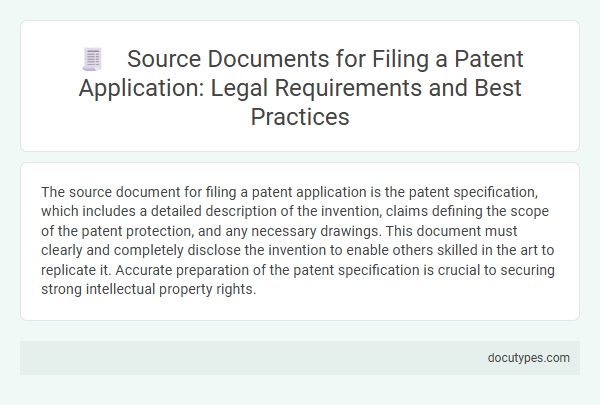The source document for filing a patent application is the patent specification, which includes a detailed description of the invention, claims defining the scope of the patent protection, and any necessary drawings. This document must clearly and completely disclose the invention to enable others skilled in the art to replicate it. Accurate preparation of the patent specification is crucial to securing strong intellectual property rights.
Introduction to Patent Application Source Documents
| Introduction to Patent Application Source Documents |
|---|
| The source document for filing a patent application is a critical legal record that serves as the foundation for protecting an invention. This document includes a detailed description of the invention, claims defining the scope of patent protection, drawings or illustrations if applicable, and an abstract summarizing the invention. The source document ensures that the patent office understands the novelty and utility of the invention, establishing the basis for patent examination and potential grant. Accurate and complete source documents are essential to secure strong intellectual property rights. Preparing your patent application source document requires careful attention to legal and technical details to meet patent office requirements and avoid rejection or delays. |
Legal Framework Governing Patent Source Documents
The source document for filing a patent application is the original patent specification, which serves as the primary legal instrument in the patent registration process. This document must comply with the legal framework governing patent disclosures to ensure enforceability and protection under intellectual property law.
- Patent statute requirements - The legal framework mandates that the source document must include a detailed description, claims, drawings (if applicable), and an abstract to meet patentability criteria.
- Compliance with patent office guidelines - Your patent application must conform to formal rules set by patent offices such as the USPTO, EPO, or WIPO to qualify as an official filing document.
- Proof of invention date - Source documents serve as evidence of the invention's priority date, critical for establishing novelty and protecting your intellectual property rights.
Mandatory Source Documents for Patent Filing
What is the mandatory source document for filing a patent application?
The primary source document required for patent filing is the patent specification, which includes the description, claims, abstract, and drawings. This document must clearly disclose the invention to satisfy legal requirements and enable examination by the patent office.
Document Authenticity and Verification Requirements
The source document for filing a patent application is the original patent specification, including claims, drawings, and any necessary abstracts. Authenticity of this document is critical to establish the inventor's rights and priority date.
Verification requirements mandate that the source document must be signed, dated, and often notarized or witnessed to ensure its legitimacy. Patent offices typically require certified copies or electronic filings with validated digital signatures to prevent fraud and maintain legal integrity.
Formatting and Language Standards for Patent Documents
The source document for filing a patent application must strictly adhere to formatting and language standards to ensure legal clarity and compliance. Proper structure and precise language improve the chances of acceptance by patent offices worldwide.
- Structured Format - The document should follow a clear layout including title, abstract, background, summary, detailed description, claims, and drawings to meet patent office requirements.
- Formal Language - Use technical and formal language specific to the invention, avoiding vague or ambiguous terms to maintain the document's legal integrity.
- Consistency and Accuracy - Ensure consistent terminology and accurate representation of the invention details to prevent misinterpretation during examination.
Best Practices for Document Collection and Organization
The source document for filing a patent application is the invention disclosure form, which details the technical aspects and novelty of the invention. Accurate and thorough information in this document is critical for drafting a strong patent application.
Best practices for document collection include gathering all relevant technical diagrams, prototype data, and previous related research. Organizing these documents by category and date ensures ease of reference during the patent drafting process.
Addressing Confidentiality and Security Concerns
The source document for filing a patent application is typically the detailed patent specification, including claims, drawings, and an abstract. Ensuring confidentiality and security of this document is critical because it contains sensitive technical information that can impact patent rights and competitive advantage. Patent offices implement strict protocols, such as secure submission portals and non-disclosure agreements, to protect applicant data during the filing process.
Common Mistakes in Patent Documentation
The source document for filing a patent application is the patent specification, which includes a detailed description of the invention, claims defining the scope of protection, and relevant drawings or diagrams. Accurate and complete documentation is critical to securing strong patent rights.
Common mistakes in patent documentation include vague descriptions, incomplete claims, and insufficient disclosure of the invention's technical details. These errors can lead to rejections, delays, or weakened patent protection. Ensuring clarity and thoroughness in the source document helps prevent costly legal challenges and ensures the patent aligns with the inventor's intentions.
Electronic vs. Physical Submission: Legal Implications
The source document for filing a patent application serves as the official record that establishes the invention's originality and filing date. Electronic submissions have become the standard in many jurisdictions, offering faster processing and immediate confirmation but require strict adherence to format and security guidelines. Physical submissions remain acceptable in certain cases but may face delays, higher costs, and increased risk of loss or damage, which carry critical legal implications for maintaining patent rights.
What Is the Source Document for Filing a Patent Application? Infographic

